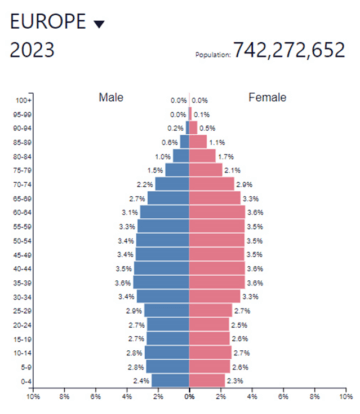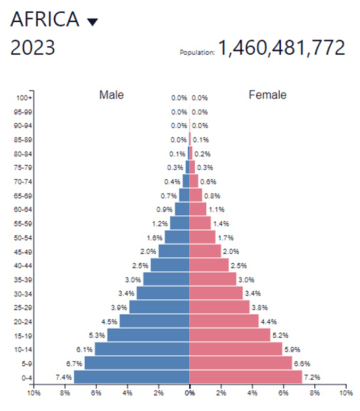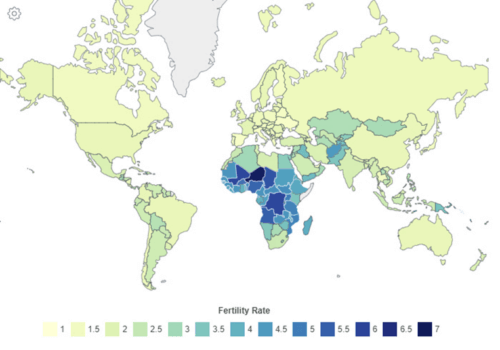by Edward Ring
Women around the world are having fewer than two children. But while population decline is well underway in most nations, there are a handful of nations that are still experiencing a population explosion. The implications of this challenge the foundations of cultural and national independence, most particularly in nations whose populations have stopped reproducing. The nations still experiencing rapid population growth have cultural traditions that stand in stark contrast to the nations with stable and declining populations. These profound demographic and cultural differences, when combined with a massive and ongoing transfer of people from high birth-rate nations into low birth-rate nations, introduces the potential for polarization on an almost unimaginable scale.
It isn’t as if the demographic trends haven’t been obvious for a very long time. In 1986, Ben Wattenberg published “The Birth Dearth,” where he pointed out that while America’s population was increasing in that decade, it was because the huge numbers of babies born during the post-WW2 baby boom were all grown up and having children. Population growth was not because young women were having lots of children. It was because a lot of mothers, born during the baby boom, had reached peak childbearing age. Per mother, children were not being born at replacement rates.
What Wattenberg was getting at can be visualized using what demographers refer to as population pyramids. Depicted below is a 2023 population pyramid for Europe. Women of prime childbearing years are shown in the 3rd and 4th rows from the bottom, where their percentage of the population is represented by the stacked red bars on the horizontal axis.
As can be seen, women aged 20-24 represent 2.5 percent of Europe’s population, and women aged 25-29 are 2.7 percent of the population. But men and women who are beyond the age when families are typically started represent larger percentages of the population. European men and women between the ages of 35 and 65, as counted in five year age groups, each represent around 3.5 of the population. The difference between Europeans aged 0-5 and those aged 60-64 is dramatic. There are nearly 60 percent more women aged 60-64 than girls aged 0-5. This is a population in rapid decline.
While overall, the population pyramid for the world indicates below replacement birthrates are already here, with an absolute population decline only one or two decades away, it would be a grave mistake to assume these demographic shifts are uniform across nations. The next population pyramid, depicted for the African continent, makes this dramatically clear. The population of Africa, already twice that of Europe, has quintupled since 1960, and continues to rapidly increase.
As shown on the chart below, the number of African women currently of child bearing age, about 4 percent of the population, is twice that of their mothers, who represent around 2 percent of the population, yet is only about half that of the babies, representing 7 percent of the population. Africa’s population is exploding, while in most of the rest of the world the population is imploding.
Even Elon Musk, a zillionaire whose fortune, at least that portion represented by his Tesla shares, would benefit from spreading climate alarm, has said that population collapse is a bigger challenge. In August 2022 he tweeted “Population collapse due to low birth rates is a much bigger risk to civilization than global warming.”
Demographers who ought to know better have ridiculed Musk for his concerns over a population implosion. From the Stanford academic journal MAHB, “Elon Musk is wrong about population growth.” From Wired, a slightly more emphatic “Elon Musk Is Totally Wrong About Population Collapse.” The general thrust of these articles is Elon Musk should stick to rockets and cars (and tunnel boring machines and AI and social media, but never mind), because there is the “joy of smaller, older populations,” and “pronatalist” policies never work.
These demographers have no credibility. For example, South Korea’s current fertility per woman is a dismal 0.78, and those are extinction-level numbers. At that rate of reproduction, for every 1 million Koreans of childbearing age today, there will only be 51,000 great-grandchildren. South Korea is on track to disappear in less than a century.
The Demographics of Polarization
There are two problems where mainstream demographers are in apparent denial. The first problem – how can the economy get bigger, or even just stay healthy, when the population is getting smaller – is easier to solve, which isn’t saying much because it compounds a perennial question that has ignited countless wars. The perennial question is what constitutes a just and equitable political economy that optimizes freedom and prosperity for all individuals.
The bloody legacy of that debate is written across the centuries, but through it all, there was a reliable assumption: every new generation will be more numerous than the one that came before it, which meant there was always growing opportunities to start businesses, find more customers, and generate wealth. And there were always more young people available to care for old people. It’s almost as if economic growth required a demographic pyramid scheme. And now that’s ending.
But there is a second, bigger problem with global demographics in this era, which is the uneven pace at which populations are shifting from growth to decline. And small wonder that Elon Musk’s warnings on this topic are dismissed as uninformed rants, because the fact that Africa’s population is exploding at the same time as the rest of the world’s population is collapsing is a phenomenon that will make any cautiously inoffensive analyst squirm. Here is a map of the nations of the world, color coded according to each nation’s rate of population growth:
It doesn’t take a lot of imagination, much less formal training in demographics, to understand what this map documents. Apart from a few nations in South and Central America, and Papua New Guinea, every nation on earth has a below replacement birth-rate. That is, until you examine the nations in Africa and parts of the Middle East and Central Asia.
It is disingenuous for demographers to suggest that slow population decline is manageable, and leave it at that. After all, maybe it is. Maybe we need to discover how to maintain economic health in a world with slow population decline. But to say it’s going to take a century before the population of the world begins to significantly drop ignores two Elephants in the room. First, as things currently stand, within a century, if not sooner, the majority of people on earth will be African, and that reality will be exacerbated by the fact that by then the overwhelming majority of people under 25 will be African, and the only segment of the global population pyramid where there might remain a majority of people who are not African will be among the very elderly.
Clearly, this is an extrapolation, and extrapolations aren’t always predictive. But they’re also not based on imaginary data. These trends are playing out at breathtaking speed around the world. In Germany, where the nation-extinguishing low birth rate has risen slightly in recent years, the recent waves of immigrants are the reason why. Fully 27 percent of Germany’s newborns in 2022 were from mothers who were born somewhere else – primarily Africa and the Middle East. This percentage understates the impact of immigration is already having on Germany’s ethnic and cultural demography, because millions of mothers born in Germany are themselves children of recent immigrants.
In Western nations, the solution to population decline is to import millions of young and fecund Africans, Middle Easterners, and Central Americans. People are being transferred, en masse, from nations with rapidly growing populations into nations with declining populations. That seems logical, although it only defers the ultimate question, which is what happens when even people from these nations stop having children. Asian nations have chosen to restrict immigration, and instead are learning to cope with declining populations through, among other things, robotics and AI. What they are not doing is replacing themselves via mass immigration.
Which brings us to the hundred trillion dollar question. Is it desirable to replace the population of Europe with the population of Africa? Is it desirable to replace the population of the United States with refugees from the swelling populations of failed, chaotic, destitute nations? And if so, is it prudent to abandon the melting pot ideal of assimilation which worked so well for the first two centuries of America’s existence as a nation, and replace it with a multicultural ideal that in has devolved into something extremists use to deliberately nurture mutual resentment between immigrants and the host population? Or if assimilation is reestablished as a universally shared national priority, can it still work? Can Americans, more diverse than ever, rediscover and embrace common values and national unity?
Over the past few weeks we have seen literally millions of Leftists join forces with millions of Middle Eastern immigrants to flood the streets of American and European cities in support of Palestine. Underlying the anti-Zionist passion of these mobs is a related but deeper shared understanding: The privileged whites of Western nations are oppressors. They are culpable for the travails of the world, from devastated ecosystems to desperately poor nations. Their culture, their capitalism, their colonialism, and their Christianity are all engines of oppression. All of it must be utterly destroyed.
At what point do tribal hatreds, or just an unprecedented level of differences in tradition and culture between immigrant and host populations, erase the potential for reconciliation and unity? What brand of charismatic leadership can motivate millions of bitter rivals to abandon ages of murderous feuds and choose to unify, and how rare is that? Can debates over what constitutes an optimal political and economic system, inherent in any democracy but enough by itself to periodically engulf nations in civil conflict, withstand in addition to that historic instability the added challenge of tribal conflicts?
This is the modern face of multiculturalism. Perhaps diversity should be a strength to be celebrated, but in practice it has become polarizing. Even 20 years ago, such demonstrations of anti-Western power in the heartlands of Western nations would have been unthinkable. But demographic shifts, propelled by a plummeting population of Americans and Europeans and a burgeoning population of Africans and Middle Easterners, enabled by corporate and political special interests in the West who believe their economic survival depends on mass migration, have turned the unthinkable into reality. And it has only just begun.
– – –
Edward Ring is a contributor to American Greatness.











